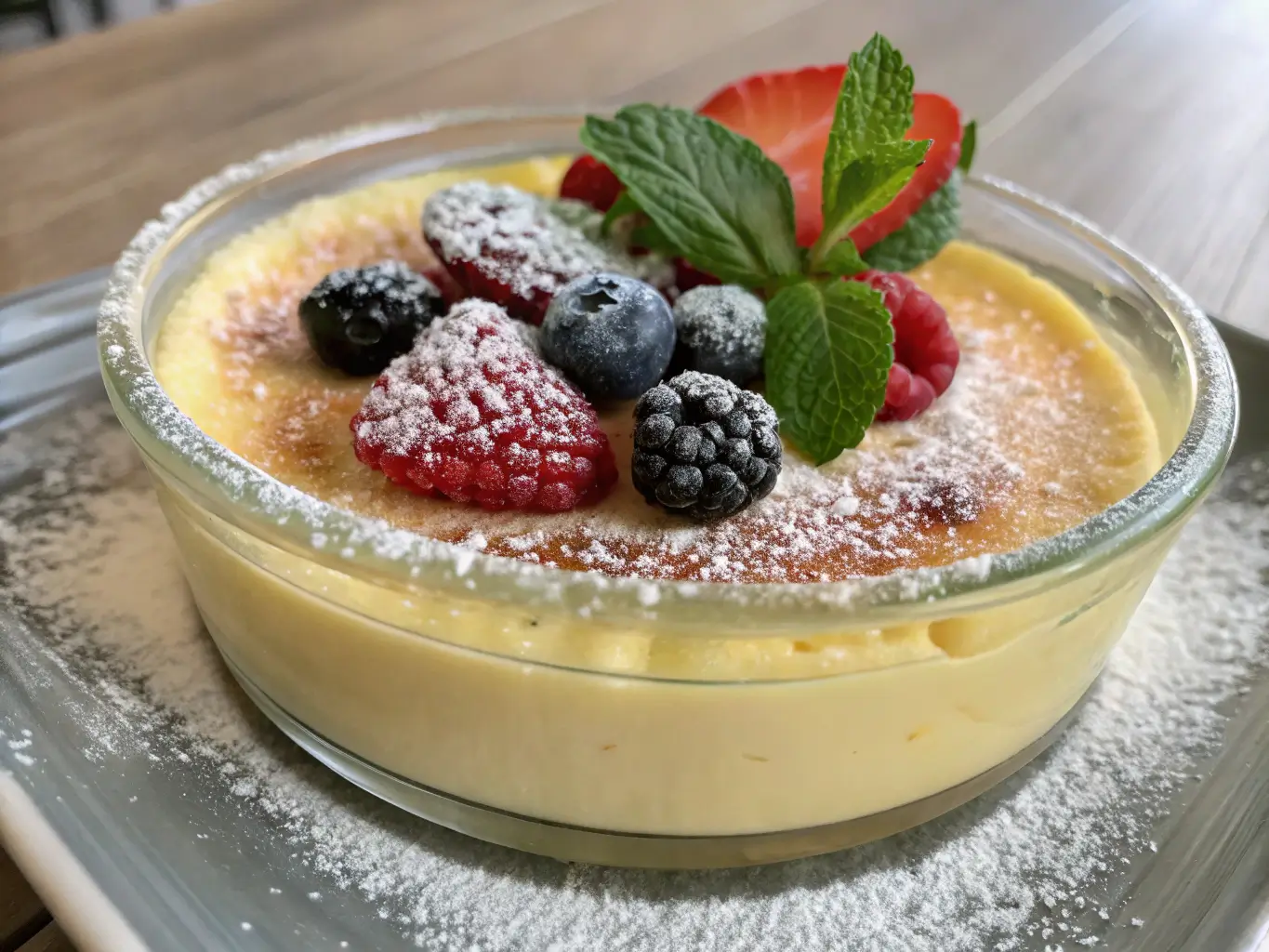Traditional French Sabayon: A Luxurious, Foolproof Guide to the Classic Dessert
Introduction
Few desserts capture the elegance of French cuisine like sabayon (also known as zabaglione in Italian). This velvety, airy custard—made with just egg yolks, sugar, and wine—is a timeless treat that’s as versatile as it is delicious. Whether served over fresh berries, paired with cake, or enjoyed on its own, sabayon transforms simple ingredients into a restaurant-worthy dessert in minutes.
What makes this recipe special?
Only 3 core ingredients – No complicated steps or hard-to-find items.
Ready in 15 minutes – Faster than most desserts!
Endlessly adaptable – Swap wine for liqueurs, citrus, or even coffee.
Naturally gluten-free – Perfect for those with dietary restrictions.
Originally a 16th-century Italian invention, sabayon was embraced by French chefs and refined into the delicate, foamy masterpiece we know today. Its name comes from the Italian zabaglione, derived from zabaja, a medieval Dalmatian custard. French patissiers elevated it by perfecting the balance of sweetness and acidity, making it a staple in fine dining.

Let’s dive into this foolproof, chef-approved method for making perfect sabayon every time—plus creative ways to serve it, expert troubleshooting, and fascinating history.
Why You’ll Love This Sabayon Recipe
- 💡 Effortless elegance – Impress guests with minimal effort.
- 🍓 Perfect pairing – Ideal with fruit, pastries, or as a dessert sauce.
- 🔥 No baking required – Cooked gently over a water bath.
- 🍽️ Versatile texture – Serve warm, chilled, or even frozen like ice cream.
Sabayon is also a fantastic base for advanced desserts. Pastry chefs use it in:
- Charlottes (layered with ladyfingers)
- Trifles (alternated with fruit and cream)
- Floating islands (poached meringue in sabayon)
Ingredients & Equipment
For the Sabayon (Serves 4)
- 4 large egg yolks (room temperature) – Fresh, organic yolks yield the richest texture.
- ½ cup (100g) granulated sugar – Adjust to taste
- 1 tsp vanilla extract or ½ vanilla bean (seeds scraped)
- Pinch of salt – Balances sweetness and enhances flavor.
Optional Enhancements
- 1 tbsp citrus zest (lemon or orange) – Brightens heavy wines.
- 1 tbsp liqueur (e.g., Grand Marnier, Amaretto, Kirsch) – Add after cooking to preserve alcohol’s kick.
- ¼ tsp cinnamon or nutmeg – Warming spice for winter variations.
- 1 tbsp unsalted butter – Whisk in at the end for extra silkiness (French “sabayon beurre”).
Equipment
- Heatproof mixing bowl (stainless steel or glass) – Avoid aluminum (can react with acid).
- Balloon whisk – Wire loops incorporate maximum air.
- Saucepan (for bain-marie) – 2–3 inches wider than the bowl to prevent steam burns.
- Thermometer (optional) – 160°F (71°C) ensures egg safety.
- Fine-mesh sieve – Strains lumps for ultra-smooth texture.
Pro Tip: Chill your serving glasses beforehand—sabayon stays fluffy longer when poured cold.
Step-by-Step Instructions
1. Prepare the Bain-Marie
- Fill a saucepan with 1–2 inches of water and bring to a gentle simmer (not boiling).
- Boiling water risks scrambling the eggs; aim for steady steam.
- Place your mixing bowl on top, ensuring it doesn’t touch the water (steam heat only).
- Tip: Wrap a kitchen towel around the bowl’s base for stability while whisking.
2. Whisk the Base
- Add egg yolks and sugar to the bowl. Whisk vigorously for 1–2 minutes until pale and slightly thickened.
- The mix should form “ribbons” that briefly hold shape before dissolving.
- Slow pouring prevents curdling; cold wine helps control cooking speed.
3. Cook to Ribbon Stage
- Continue whisking constantly for 8–10 minutes. The mixture should:
- Triple in volume (like a light mousse).
- Reach 160°F (71°C) for food safety.
- Coat the back of a spoon thickly (the “ribbon test”).
- Drag a finger through it—if the line holds, it’s done.
- Troubleshooting:
- If grains form, immediately remove from heat and whisk in 1 tbsp cold water.
4. Finish & Serve
- Remove from heat. Whisk in vanilla, zest, or butter if using.
- For ultra-smooth texture, strain through a sieve.
- Serve immediately (sabayon deflates as it cools) over:
- Fresh berries (strawberries, raspberries)
- Sponge cake (like ladyfingers or génoise)
- Poached pears or figs
Chef’s Secret: For a dramatic presentation, torch the top lightly with a kitchen torch for caramelized notes.
Expert Tips & Troubleshooting
Perfect Texture Every Time
- 🚫 Curdling? The heat’s too high! Reduce to low and whisk faster.
- 💦 Too thin? Cook longer (up to 12 mins) or add an extra yolk.
- 🍋 Too sweet? Balance with a splash of lemon juice or a pinch of salt.
- ⏳ Make-ahead? Sabayon is best fresh, but you can hold it for 30 mins in a warm water bath.
Advanced Techniques
- Stabilized Sabayon: Fold in 1 tsp cornstarch dissolved in wine pre-cooking for a longer-lasting foam.
- Chilled Version: Whip ½ cup heavy cream to stiff peaks, then fold into cooled sabayon for a mousse.
Variations & Customizations
- Chocolate Sabayon – Whisk in 2 tbsp cocoa powder + 1 oz melted dark chocolate at the end.
- Citrus Burst – Use limoncello or Cointreau + zest of 1 lemon.
- Coffee Sabayon – Replace wine with 2 tbsp espresso + 1 tbsp Kahlúa.
- Savory Twist – Omit sugar, use dry white wine + parmesan for a pasta sauce.
Serving & Presentation Ideas
Classic Pairings
- 🍷 Aperitif Style: In a champagne flute with raspberries and mint.
- 🍨 Decadent Parfait: Layer with whipped cream and crushed amaretti.
- 🔥 Flambé Drama: Heat 1 tbsp rum in a spoon, ignite, and pour over sabayon.
Modern Twists
- Deconstructed Trifle: Alternate sabayon with berry compote and crumbled meringue.
- Frozen Sabayon: Churn in an ice cream maker for a boozy semifreddo.
Storage & Make-Ahead Tips
- ❄️ Fridge: Store (covered) for 1 day, but texture suffers. Re-whisk before use.
- 🔥 Reheat: Gently over bain-marie while whisking.
- Freezing: Not recommended (separates when thawed).

FAQ Section
Q: Can I make sabayon without alcohol?
A: Yes! Substitute wine with apple juice, citrus juice, or strong tea. Reduce sugar if using sweet substitutes.
Q: Why did my sabayon collapse?
A: Overcooking or stopping the whisking breaks the emulsion. Keep it moving!
Q: Is sabayon safe for pregnant women?
A: If pasteurized eggs are used and the mix reaches 160°F (71°C), yes.
Q: Can I use a hand mixer?
A: Whisking by hand ensures better control, but a mixer on low speed works—just watch for over-aeration.
Conclusion
Sabayon is the ultimate “fancy but easy” dessert—a silky, sophisticated staple that’s stood the test of time. From its humble Italian roots to its place in Michelin-starred kitchens, this 3-ingredient wonder proves that French cuisine doesn’t have to be complicated.
Ready to whisk your way to dessert heaven? Try this recipe tonight, experiment with flavors, and share your creations with #FrenchSabayonMagic! 🍷✨
P.S. For a showstopping brunch, drizzle sabayon over waffles with caramelized bananas—you’ll never go back to maple syrup!

